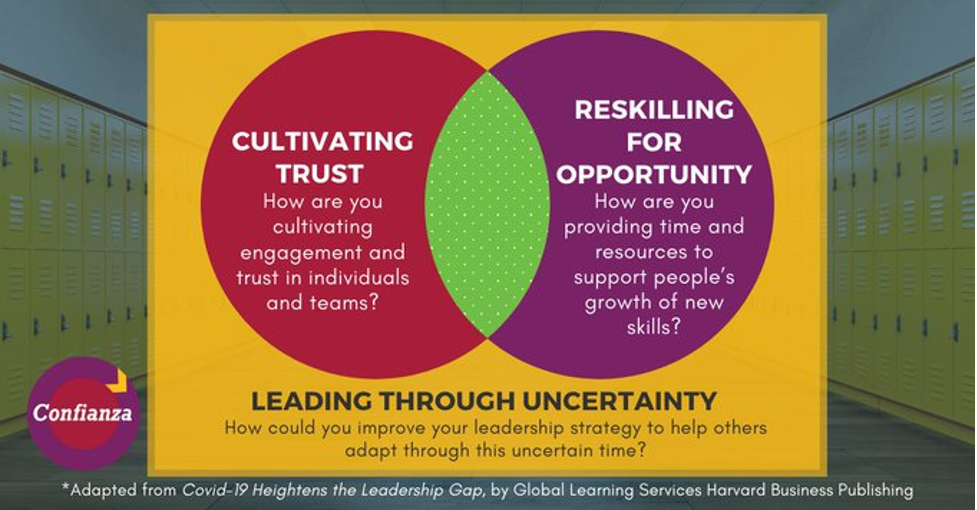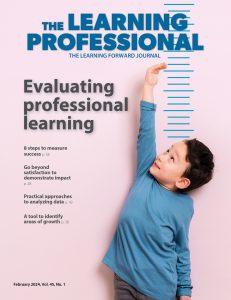“We are stuck in logistics land,” is something I hear from instructional leaders I support almost daily. For many of us, this is all too true right now. Logistics are still very much the focus during this ongoing pandemic. Many schools are still having issues with poor Wi-Fi, lack of available devices, engaging students in new modalities, and helping families navigate new digital tools. Many districts are focused on making decisions about staying in a hybrid learning model or going fully remote while coronavirus numbers increase in their surrounding communities.
But even though this is a very challenging time, we must maintain our focus on teaching and student learning. When we started online teaching and learning in Spring 2020, many of us thought it would be “emergency remote teaching” for a short time only, but it has become a new way of teaching, learning, and leading that’s here to stay, at least for a while.
Given the ongoing nature of this situation, what can instructional leaders do to support others effectively during this global pandemic? One way to think about steps they can take is to look through the lens of three pillars of leadership described in a recent study published by Harvard Business Publishing in June 2020. The study, conducted by the Global Learning Services team, looked at how leaders from different industries across the globe have responded to and adapted through the COVID-19 pandemic. Although leaders often experienced high levels of uncertainty even before the pandemic, their responsibilities are now vastly shifting and the demands on them have greatly accelerated over the past year.
What can instructional leaders do to support others effectively during this global pandemic? Click To TweetThe three pillars they identified for leaders navigating these shifting demands are: 1) Leading through uncertainty, 2) Cultivating trust and transparency, and 3) Reskilling for opportunity. These principles can help our schools not simply survive but reach towards thriving through this uncertain time.

Leading through uncertainty
The progress of an effective leader is not impeded by ambiguity. Indeed, ambiguity comes with the job of any leader. This time of heightened uncertainty requires us to try new things and encourage others to do the same. We need to foster a growth mindset in ourselves and others now more than ever.
“What we don’t know scares us,” a leader shared with me the other day, explaining how some of his staff are anxious, some are striving for perfection, and others are resistant to change. We all have different responses to stressors and so it’s important that we, as leaders, model an inquiry-based approach.
''We all have different responses to stressors and so it’s important that we, as leaders, model an inquiry-based approach.'' @SarahOttow Click To TweetWe need to learn from what’s not working and execute the next steps within our sphere of influence. As leaders, we need to stress that success might look a lot different right now than what we are all used to. As one principal told me recently, “We are all failing greatly right now and that’s part of the process.” If failing is part of trying new things, then let’s redefine what success is and be sure to celebrate the small wins along the way.
Some guiding questions for leading through uncertainty are:
- What is your own personal comfort level with normalizing change?
- How could you improve your leadership strategy to help others adapt through this uncertain time?
Ideas to move forward:
Try stepping back and assessing how you feel about change in general. Is change easy for you? Is it hard? What about change that you can’t control or didn’t bring about? If you can honestly answer these questions to yourself then you may try modeling that self-talk for your staff. Be really transparent about how difficult or uneasy or uncomfortable you may sometimes feel during this challenging time. Authenticity is a key part of leadership, especially when paired with attuning your emotional intelligence. In fact, leaders perform well when being cognizant of using both analytical and emotional parts of the brain.
''Leaders perform well when being cognizant of using both analytical and emotional parts of the brain.'' @SarahOttow Click To TweetCultivating trust and transparency
Leaders have a critical role in supporting others’ emotional and physical health as we all struggle to balance home and work and navigate the stress of current events. As leaders, it is imperative that we make time and space to process together in this grey area and to process what we are experiencing together without judgment, fear, or more stress. As global literacy researcher Marie Clay teaches us, there is a lot of value in “roaming the known” in our Zones of Actual Development, not just forging ahead to what’s next in the Zone of Proximal Development.
We can be a little bit gentler with ourselves and with each other. “It’s the Year of Forgiveness,” is a helpful mantra to tell ourselves and others we support. As leaders, we should be giving more autonomy, not less, and work hard to build a shared vision and strong community across our remote staff and stakeholders during this time of an unclear future. While leading virtually is not a skill set or a toolkit every leader has, we can and must promote connection, collaboration, and engagement so that everyone can move forward together.
''While leading virtually is not a skill set or a toolkit every leader has, we can and must promote connection, collaboration, and engagement.'' @SarahOttow Click To TweetWe can also support others by continuously linking others’ roles to the larger purpose at hand which is to provide education to all students across our community.
Some guiding questions for cultivating trust and transparency are:
- How are you currently cultivating engagement and trust with individuals and teams?
- How could you improve so that everyone has access to community and support?
Ideas to move forward:
Everyone responds to change in different ways and it’s our job, as leaders, to understand what motivates each person we support. If certain individuals or teams are pulling away or outright resisting change, try what I call the “nudge” approach, instead of trying to push them forward on your timeline. Figure out what their perspective is and build compassion and empathy based on that.
This means taking the time to ask open-ended questions, such as “Can you help me understand what barriers you see?” and “What are we missing?” Above all, listen, listen, listen. I find that when we differentiate our support for individuals and teams along the continuum of embracing change, we can more efficiently get to the root cause of discomfort and even barriers to change that we didn’t see. Empathy is a key ingredient for supporting change.
Reskilling for opportunity
Leaders should be sure that teams are focused on the innovation needed to adapt to the changing landscape of schooling right now and into the future. They should provide support for learning new skills while also having time and space to process and roam the know. Like English Language Learners acquiring a new language, it’s more practical and useful to focus on growth than proficiency.
To close achievement gaps during the pandemic, we must build digital fluency. New tools and platforms provide opportunities to make teaching and learning exciting, more personalized, and focused on 21st-century skills for students beyond their K-12 education to their future beyond. We can make the connections for teachers to transfer what works in face-to-face instruction to remote environments.
''To close achievement gaps during the pandemic, we must build digital fluency.'' @SarahOttow Click To TweetAt the same time, the classroom practices that worked before don’t just go away. We still need to focus on cultivating a learning community, connecting students’ identities to rigorous content, and quick plan-teach-assess cycles to guide our instruction and leadership.
Some guiding questions for reskilling for opportunity are:
- How are you providing time, space, and resources to support growth of new skills?
- How could you improve opportunities for others to learn new skills?
Ideas to move forward:
Bring all stakeholders together at key times to help shape teaming structures. For example, ask teachers what they need and keep an open line of communication with families to check in on them and hear their concerns, hopes, and fears. We need to recognize that everyone is upskilling on a steep learning curve and support that in real time. Practice what you preach by using the tech tools and new ways of communicating in remote and hybrid settings while you lead meetings and professional development. Model authenticity by admitting that you don’t have all the answers. Hand the baton to teachers, other staff, and families to share knowledge and tools.
Leaders have a lot of power. Part of this power includes becoming stronger in this uncertain time, perhaps even finding more opportunities for innovation and collaboration. I hope that you will find, as I am finding, this time to be an opportunity to learn more about myself and others. As challenging as it is, we can do more than just survive; we can find ways of thriving, together.








